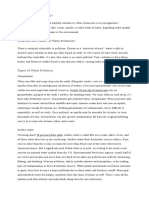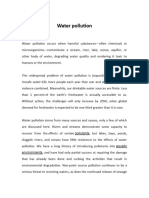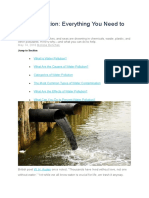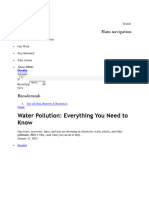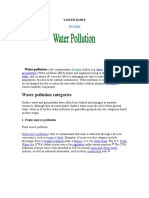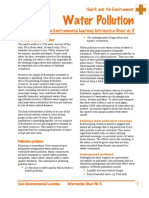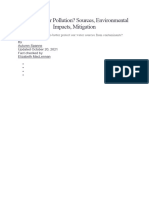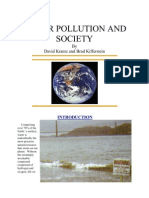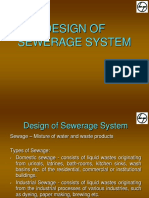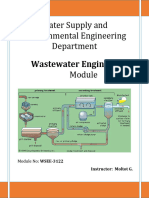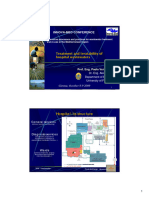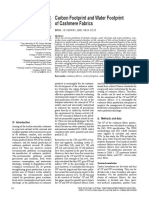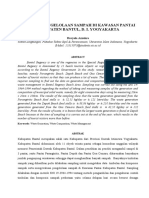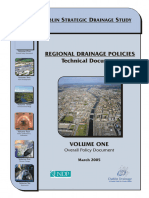0 ratings0% found this document useful (0 votes)
9 viewsWhat Is Water Pollution?: One-Third Greater
What Is Water Pollution?: One-Third Greater
Uploaded by
sanskrutihbgood
Copyright:
© All Rights Reserved
Available Formats
Download as DOCX, PDF, TXT or read online from Scribd
What Is Water Pollution?: One-Third Greater
What Is Water Pollution?: One-Third Greater
Uploaded by
sanskrutihb0 ratings0% found this document useful (0 votes)
9 views4 pagesgood
Original Title
sst
Copyright
© © All Rights Reserved
Available Formats
DOCX, PDF, TXT or read online from Scribd
Share this document
Did you find this document useful?
Is this content inappropriate?
good
Copyright:
© All Rights Reserved
Available Formats
Download as DOCX, PDF, TXT or read online from Scribd
Download as docx, pdf, or txt
0 ratings0% found this document useful (0 votes)
9 views4 pagesWhat Is Water Pollution?: One-Third Greater
What Is Water Pollution?: One-Third Greater
Uploaded by
sanskrutihbgood
Copyright:
© All Rights Reserved
Available Formats
Download as DOCX, PDF, TXT or read online from Scribd
Download as docx, pdf, or txt
You are on page 1of 4
What Is Water Pollution?
Water pollution occurs when harmful substances—often
chemicals or microorganisms—contaminate a stream, river, lake,
ocean, aquifer, or other body of water, degrading water quality
and rendering it toxic to humans or the environment.
This widespread problem of water pollution is jeopardizing our
health. Unsafe water kills more people each year than war and all
other forms of violence combined. Meanwhile, our drinkable
water sources are finite: Less than 1 percent of the earth’s
freshwater is actually accessible to us. Without action, the
challenges will only increase by 2050, when global demand for
freshwater is expected to be one-third greater than it is now.
What Are the Causes of Water Pollution?
Water is uniquely vulnerable to pollution. Known as a “universal
solvent,” water is able to dissolve more substances than any
other liquid on earth. It’s the reason we have Kool-Aid and
brilliant blue waterfalls. It’s also why water is so easily polluted.
Toxic substances from farms, towns, and factories readily
dissolve into and mix with it, causing water pollution.
Here are some of the major sources of water pollution worldwide:
Agricultural
Toxic green algae in Copco Reservoir, northern California
Not only is the agricultural sector the biggest consumer of global
freshwater resources, with farming and livestock production
using about 70 percent of the earth’s surface water supplies , but
it’s also a serious water polluter. Around the world, agriculture is
the leading cause of water degradation. In the United
States, agricultural pollution is the top source of contamination in
rivers and streams, the second-biggest source in wetlands, and
the third main source in lakes. It’s also a major contributor of
contamination to estuaries and groundwater. Every time it rains,
fertilizers, pesticides, and animal waste from farms and livestock
operations wash nutrients and pathogens—such bacteria and
viruses—into our waterways. Nutrient pollution, caused by excess
nitrogen and phosphorus in water or air, is the number-one threat
to water quality worldwide and can cause algal blooms, a toxic
soup of blue-green algae that can be harmful to people and
wildlife.
Sewage and wastewater
Used water is wastewater. It comes from our sinks, showers, and
toilets (think sewage) and from commercial, industrial, and
agricultural activities (think metals, solvents, and toxic sludge).
The term also includes stormwater runoff, which occurs when
rainfall carries road salts, oil, grease, chemicals, and debris from
impermeable surfaces into our waterways
More than 80 percent of the world’s wastewater flows back into
the environment without being treated or reused, according to
the United Nations; in some least-developed countries, the figure
tops 95 percent. In the United States, wastewater treatment
facilities process about 34 billion gallons of wastewater per day .
These facilities reduce the amount of pollutants such as
pathogens, phosphorus, and nitrogen in sewage, as well as heavy
metals and toxic chemicals in industrial waste, before discharging
the treated waters back into waterways. That’s when all goes
well. But according to EPA estimates, our nation’s aging and
easily overwhelmed sewage treatment systems also release
more than 850 billion gallons of untreated wastewater each year.
Ocean water pollution
Eighty percent of ocean pollution (also called marine pollution)
originates on land—whether along the coast or far inland.
Contaminants such as chemicals, nutrients, and heavy metals are
carried from farms, factories, and cities by streams and rivers
into our bays and estuaries; from there they travel out to sea.
Meanwhile, marine debris—particularly plastic—is blown in by the
wind or washed in via storm drains and sewers. Our seas are also
sometimes spoiled by oil spills and leaks—big and small—and are
consistently soaking up carbon pollution from the air. The ocean
absorbs as much as a quarter of man-made carbon emissions .
What Are the Effects of Water Pollution?
On human health
To put it bluntly: Water pollution kills. In fact, it caused 1.8 million
deaths in 2015, according to a study published in The Lancet.
Contaminated water can also make you ill. Every year, unsafe
water sickens about 1 billion people. And low-income
communities are disproportionately at risk because their homes
are often closest to the most polluting industries.
Waterborne pathogens, in the form of disease-causing bacteria
and viruses from human and animal waste, are a major cause of
illness from contaminated drinking water. Diseases spread by
unsafe water include cholera, giardia, and typhoid. Even in
wealthy nations, accidental or illegal releases from sewage
treatment facilities, as well as runoff from farms and urban areas,
contribute harmful pathogens to waterways. Thousands of people
across the United States are sickened every year by
Legionnaires’ disease (a severe form of pneumonia contracted
from water sources like cooling towers and piped water), with
cases cropping up from California’s Disneyland to Manhattan’s
Upper East Side.
A woman using bottled water to wash her three-week-old son at
their home in Flint, Michiga n
How we can reduce Water Pollution?
Reduce your plastic consumption and reuse or recycle
plastic when you can.
Properly dispose of chemical cleaners, oils, and
nonbiodegradable items to keep them from going down the
drain.
If you have a pup, be sure to pick up its poop.
You might also like
- Post Doctoral Research ProposalDocument6 pagesPost Doctoral Research Proposaleph100% (1)
- Types of Sewerage Systems in Waste Water EngineeringDocument8 pagesTypes of Sewerage Systems in Waste Water EngineeringMd. Jahidul IslamNo ratings yet
- What Is Water PollutionDocument7 pagesWhat Is Water PollutionRhianne SaminianoNo ratings yet
- Concept PaperDocument11 pagesConcept PaperRaica Mel CorpuzNo ratings yet
- Environment Water PolutionDocument7 pagesEnvironment Water PolutionmaniiNo ratings yet
- Water PollutionDocument6 pagesWater PollutionRaghav DuaNo ratings yet
- Water Pollution: Everything You Need To KnowDocument7 pagesWater Pollution: Everything You Need To KnowManu Jacob Steaphen 19MST0050No ratings yet
- Water PollutionDocument5 pagesWater Pollutionariana akbarNo ratings yet
- What Is Water PollutionDocument9 pagesWhat Is Water PollutionSatya MohapatraNo ratings yet
- Water PollutionDocument5 pagesWater Pollutiondipikathakare5112010No ratings yet
- Water PollutionDocument12 pagesWater PollutionSha TomasNo ratings yet
- W. H. Auden 80 Percent of The World's WastewaterDocument5 pagesW. H. Auden 80 Percent of The World's WastewaterAkshay SarjanNo ratings yet
- Water Pollution: Everything You Need To Know: Main NavigationDocument14 pagesWater Pollution: Everything You Need To Know: Main Navigationdpasi2338No ratings yet
- What Is Water PollutionDocument6 pagesWhat Is Water Pollutiondevvie realistaNo ratings yet
- Water Act, 1974Document12 pagesWater Act, 1974AkshitaNo ratings yet
- Evs ProjectDocument11 pagesEvs ProjectmitsuhaNo ratings yet
- Water PollutionDocument4 pagesWater Pollutiontarasonagrace21No ratings yet
- Esci 213 Environmental Science and Engineering (Finals)Document14 pagesEsci 213 Environmental Science and Engineering (Finals)Bea SaguinsinNo ratings yet
- The Problem and Its BackgroundDocument7 pagesThe Problem and Its BackgroundMarjorieNo ratings yet
- Water PollutionDocument4 pagesWater Pollutionmiszja29No ratings yet
- Water PollutionDocument6 pagesWater PollutionNicholas WhiteNo ratings yet
- The Complex Environmental Pollution Which Faced in Malaysia Have A Long History and Is Becoming Serious Since The Last Decade Due To The Economic Development and Increased Industrialization ActivitiesDocument7 pagesThe Complex Environmental Pollution Which Faced in Malaysia Have A Long History and Is Becoming Serious Since The Last Decade Due To The Economic Development and Increased Industrialization ActivitiesSITI SAHIRAHNo ratings yet
- Term ProjectDocument6 pagesTerm ProjectYasser RabeeNo ratings yet
- Water Pollution and Global WarmingDocument28 pagesWater Pollution and Global WarmingNadeem A. KhanNo ratings yet
- Water PollutionDocument5 pagesWater PollutionFahiem ChaucerNo ratings yet
- Causes and Effects of Water PollutionDocument2 pagesCauses and Effects of Water PollutionThal LiaNo ratings yet
- Water PollutionDocument4 pagesWater PollutionMariano DomingoNo ratings yet
- What Is Water PollutionDocument11 pagesWhat Is Water Pollutionmuskaan.kukrejaNo ratings yet
- Environmental Engineering Lec 3Document33 pagesEnvironmental Engineering Lec 3yaseen10388No ratings yet
- Ducksters ArticleDocument3 pagesDucksters Articleapi-644963967No ratings yet
- Introduction To Water PollutionDocument5 pagesIntroduction To Water PollutionYashvi RaiNo ratings yet
- College of Engineering, Architecture and Technology: Water PollutionDocument7 pagesCollege of Engineering, Architecture and Technology: Water PollutionFirst name Last nameNo ratings yet
- Causes Effects of Water Pollution Environmental Sciences EssayDocument3 pagesCauses Effects of Water Pollution Environmental Sciences EssayBradley GarciaNo ratings yet
- Water PollutionDocument11 pagesWater PollutionAlin SanduNo ratings yet
- Pollution of The WaterDocument25 pagesPollution of The WaterJeprox Martinez100% (1)
- Environmental Engineering Lec 3Document33 pagesEnvironmental Engineering Lec 3yaseen10388No ratings yet
- Ecology: Science ProjectDocument13 pagesEcology: Science Projectabdullah ahsanNo ratings yet
- Water Pollution SBADocument3 pagesWater Pollution SBARodaine MooreNo ratings yet
- What Is Water PollutionDocument13 pagesWhat Is Water PollutionYudeimy Vargas NiñoNo ratings yet
- Cause and Effects of Water PollutionDocument3 pagesCause and Effects of Water PollutionAizer MogahedNo ratings yet
- Water Pollution and Control - DocxppDocument26 pagesWater Pollution and Control - DocxppGraphic DesignerNo ratings yet
- Water PollutionDocument16 pagesWater Pollutionwan habibahNo ratings yet
- Chapter 2 Jelay UndoneDocument12 pagesChapter 2 Jelay UndoneKristal CaberioNo ratings yet
- Water Pollution and SocietyDocument12 pagesWater Pollution and SocietyRaja_ne23100% (1)
- Cause and Effects of Water PollutionDocument3 pagesCause and Effects of Water Pollutionronnda67% (6)
- Water Pollution07Document12 pagesWater Pollution07mechjobs4me100% (1)
- What Is Water PollutionDocument3 pagesWhat Is Water PollutionJessica NacesNo ratings yet
- 15876184390EVSAECC01 Water PollutionDocument8 pages15876184390EVSAECC01 Water Pollutionsharmaryan0805No ratings yet
- Communication Skills PPT Unit 1Document13 pagesCommunication Skills PPT Unit 1AnishSaxenaNo ratings yet
- Operational Definition of Terms GroundwaterDocument11 pagesOperational Definition of Terms GroundwaterBernadeth A. UrsuaNo ratings yet
- Fresh WaterDocument13 pagesFresh WaterNissreen SapryNo ratings yet
- Water Pollution and Its Control: Case StudyDocument13 pagesWater Pollution and Its Control: Case StudySE HariharasudhanNo ratings yet
- Chemistry Environmental Study Water PollutionDocument12 pagesChemistry Environmental Study Water PollutionzazabanazaNo ratings yet
- Sources of Water Pollution and Its Effect On Aquatic LifeDocument3 pagesSources of Water Pollution and Its Effect On Aquatic LifeMarvi DahotNo ratings yet
- Water Pollution PDFDocument11 pagesWater Pollution PDFalbynbabuNo ratings yet
- Water Pollution: Distribution of The Water On EarthDocument8 pagesWater Pollution: Distribution of The Water On EarthHimanshu Shetty100% (1)
- DssddsDocument2 pagesDssddsOto Öttozje DvoržakNo ratings yet
- Water PollutionDocument5 pagesWater PollutionSiti Ayu MegawatiNo ratings yet
- Water Pollution: Prepared byDocument12 pagesWater Pollution: Prepared byShaila IvoryNo ratings yet
- Did Your Can of Soda Kill A Whale? Water Pollution for Kids | Children's Environment BooksFrom EverandDid Your Can of Soda Kill A Whale? Water Pollution for Kids | Children's Environment BooksNo ratings yet
- Cost MBBRDocument6 pagesCost MBBRMaria Alejandra Colonia MoyaNo ratings yet
- Septic Tank and SoakawaysDocument8 pagesSeptic Tank and SoakawaysBobolaNo ratings yet
- Industrial Training Report DraftDocument27 pagesIndustrial Training Report DraftAbhinav VermaNo ratings yet
- Specification For Sewer Bricks (: Indian StandardDocument5 pagesSpecification For Sewer Bricks (: Indian StandardAnonymous i6zgzUvNo ratings yet
- 2cmc ToR For Sewarage System Design AdamaDocument11 pages2cmc ToR For Sewarage System Design AdamaAnonymous 67xRG0eINNo ratings yet
- Investigative Studies On Impact of Waste Water Irrigation On Soil Characteristics and Crop QualityDocument10 pagesInvestigative Studies On Impact of Waste Water Irrigation On Soil Characteristics and Crop Qualitymaran2326No ratings yet
- Practice Questions 1 Human ImpactDocument9 pagesPractice Questions 1 Human ImpactHifsa batoolNo ratings yet
- Role of Pharmacist in Pharmaceutical Waste ManagementDocument14 pagesRole of Pharmacist in Pharmaceutical Waste ManagementDenise Yanci DemiarNo ratings yet
- 1 Vision EngineersDocument49 pages1 Vision EngineersAmit MallickNo ratings yet
- Tzed Homes: Case StudyDocument10 pagesTzed Homes: Case StudyKunal MathurkarNo ratings yet
- Water Sanitation and ConservationDocument20 pagesWater Sanitation and ConservationJasmine Erica Certeza100% (4)
- Design of Sewerage SystemDocument51 pagesDesign of Sewerage SystemShiela SorinoNo ratings yet
- Chapter 1 - Basic Principles of Plumbing DesignDocument20 pagesChapter 1 - Basic Principles of Plumbing DesignCamille SalmasanNo ratings yet
- Plumber Lecture Design Guide PDFDocument32 pagesPlumber Lecture Design Guide PDFNick GeneseNo ratings yet
- Water Pollution Assessment ThesisDocument7 pagesWater Pollution Assessment Thesisteresaoakmanevansville100% (2)
- Introduction To Wastewater ManagementDocument18 pagesIntroduction To Wastewater ManagementMuhammad IqmalNo ratings yet
- Engineering Geo FinalDocument14 pagesEngineering Geo FinalMy BusinessNo ratings yet
- Ayodhya Final ReportDocument67 pagesAyodhya Final ReportTushar ShakyaNo ratings yet
- ASPCL NextGen CreativeBrief EnglishDocument4 pagesASPCL NextGen CreativeBrief Englishjunaidsalman2008No ratings yet
- Complete Project ReportDocument85 pagesComplete Project ReportPrashant VyasNo ratings yet
- Wastewater Engineering-I MODULEDocument177 pagesWastewater Engineering-I MODULEmoltot getahun100% (1)
- Special LawsDocument34 pagesSpecial LawsGel MaulionNo ratings yet
- VerlicchiDocument20 pagesVerlicchiMahmudul HasanNo ratings yet
- Part A, Part B Questions Unit I EE IIDocument21 pagesPart A, Part B Questions Unit I EE IIsubhaNo ratings yet
- 148 14 94 5541 DrukDocument6 pages148 14 94 5541 DrukNicole Forero SacristanNo ratings yet
- Evaluasi Pengelolaan Sampah Di Kawasan Pantai Kabupaten Bantul, D. I. YogyakartaDocument14 pagesEvaluasi Pengelolaan Sampah Di Kawasan Pantai Kabupaten Bantul, D. I. YogyakartaRavyola AzzahraNo ratings yet
- Vol 01 Overall Policy Document March 2005Document24 pagesVol 01 Overall Policy Document March 2005p.jacob.cundallNo ratings yet
- Discussion 2 - 22 Basic Principles of Plumbing-1Document16 pagesDiscussion 2 - 22 Basic Principles of Plumbing-1Shan Troy Jamero IbarraNo ratings yet


